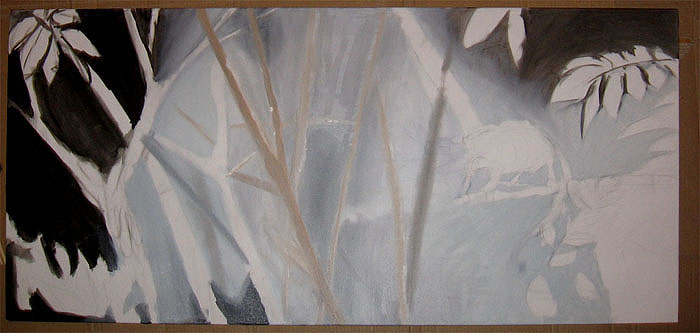Here and today you are allowed to watch live the making of my new oil painting. I want to paint a chameleon which is shooting it's tongue over the whole picture. If your want to learn painting with oil paints you can do this guide as an exercise to improve your skills. Or you can learn here what care about when painting with oil paints. I'm learning something new everytime as well ;-).
The nice thing about painting with oil colors is that they are very slow drying. This way you can mix colors into your painting for a longer time and make thus beautiful color gradients. If the colors are dried, you can also paint over it again without resolving the dryed colour. That makes the oil colours suitable to paint extremely spontaneously and without concept. This is e.g. a big difference to the coloured pencils, which I use very often.
With crayons you can't draw over you drawing afterwards, so you have to know from the start what should be on which place. Spontaneous ideas can't be submitted later and the drawing can hardly be corrected. Therefore oil paints are a good thing in my opinion if you want to learn and practise painting. Therefore no fear of oil paints, as you can still mend small accidents.
You know there is no precise plan necessary so I draw just a few sketches on the block. The rest comes during paintingv :-). Planing just spoils the fun and we must finally take the advantage of the oil paints.
In the sketch I just consider which object should be where and what I will be painting at all. I determine the position of objects on the screen and the colors. Then I have already a rough idea of the overall picture.
Now I'm drawing a presketch on the canvas according to the sketch on the paper. The presketch doesn't have to be too exactely, as the sktech will be over painted anyway. But I want to keep a few spaces free of colour (eg. where the chameleon will be, or the major branches), so that I don't lose the overview, and I even know about how everything was distributed.
So finally we can start to brush! First I paint the background colors. I dilute the oil colours with solvent (turpentine), to make them easier to paint.
I start with the farest background, which doesn't has to be painted so detailed and neatly. Everything in the foreground will be painted later. That means that I will paint one "level" after the other and I will paint with every level more detils into the picture. This saves me from the trouble that I have to paint leafs, branches and anything else in the background at the end neatly around the chameleon.
You can do it in another way as well of course. Especially when you already know exactly how the picture should look like (for example, if you copy a picture 1:1). But in my case the strategy with the levels should be better.

Set up the first background
This website is about how to draw and paint. You will learn to use pencil and brush and how to drawn and paint your own pictures.